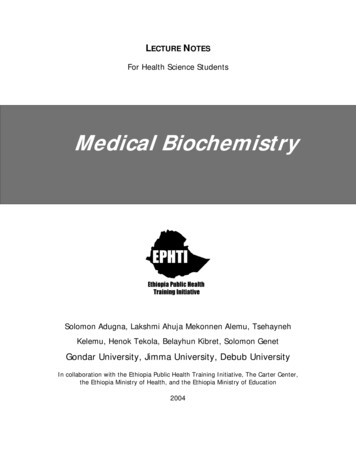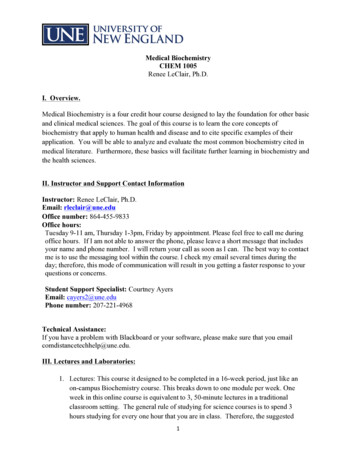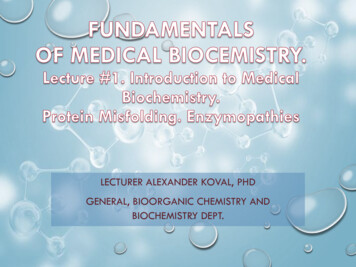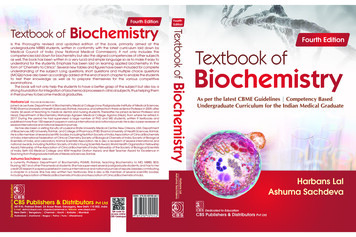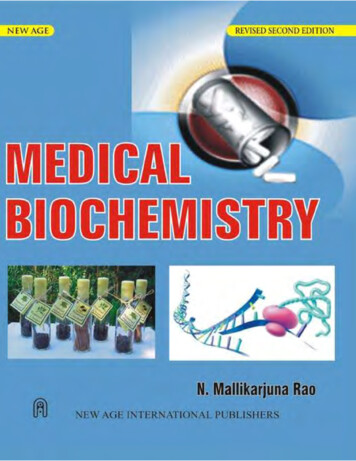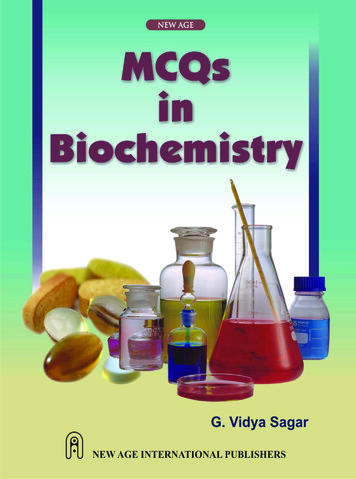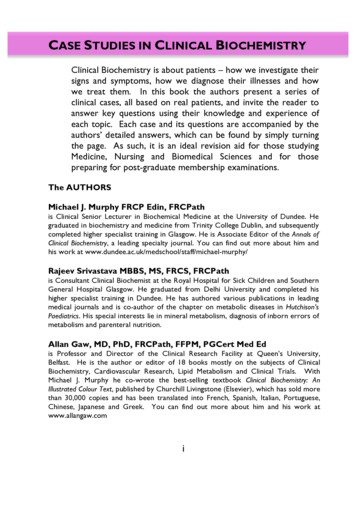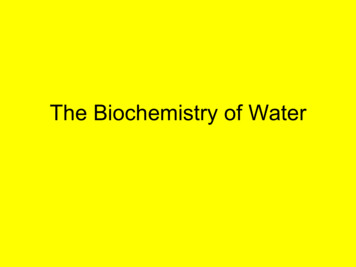
Transcription
The Biochemistry of Water
The Biochemistry of Water 2.3 Water, pH, and Buffers Water is the solvent of life All organisms are composed primarily of water, suchthat most eukaryotic organisms are about 90 percentwater while prokaryotes are about 70 percent water. Noorganism, not even the prokaryotes, can develop andgrow without water. All chemical reactions in organisms occur in liquidwater. Being polar, water has unique properties. These includeits role as a solvent, as a chemical reactant, and as afactor to maintain a fairly constant temperature.
Water Has Several Unique PropertiesLiquid water is the medium in which all cellular chemical reactions occur.Being polar, water molecules are attracted to other polar molecules and act asthe universal solvent in cells. Take for example what happens when you put a solute like salt in water.The solute dissolves into separate sodium and chloride ions because watermolecules break the weak ionic bonds and surround each ion in asphere of water molecules.An aqueous solution, which consists of solutes in water, is essential forchemical reactions to occur Water molecules also are reactants in many chemical reactions. The exampleof the hydrolysis reaction shown at the top of this page involved water insplitting maltose into separate molecules of glucose and glucose.As you have learned, the polar nature of water molecules leads to hydrogenbonding.By forming a large number of hydrogen bonds between water molecules, ittakes a large amount of heat energy to increase the temper ature of water.Likewise, a large amount of heat must be lost before water decreases tem perature.So, by being 70 to 90 percent water, cells are bathed in a solvent that maintainsa more consistent temperature change.
Figure 02.06: Solutes dissolve in water
Dissolution of NaCl in H2O
Water Water contains polar covalent bonds becauseoxygen and hydrogen do not share electronsequally Oxygen exerts a greater pull on the electrons andgains a negative charge Hydrogen as a result has a positive charge As a result – the water molecule has a positiveend (the hydrogen atoms) The oxygen is slightly negative This forms a dipole – a polar covalentmolecule
H2O – a polar molecule
Properties of water Very polar Oxygen is highly electronegative H-bond donor and acceptor High b.p., m.p., heat of vaporization, surfacetension
Properties of Water Water Has Several Unique Properties Water exists in three states ( Liquid – aquaticenvironment outside us and inside us), solid (ice) andgas (steam) 1. Surface Tension- cell membranes moist,protection. Ex. Capillary action in plant roots, attraction to glassmeniscus. 2. Cohesion- water molecules stick to each otherheld together by H-bonds. 3. Adhesion- water molecules stick to unlike surfacessuch as glass or plastic due to H-bonds betweenwater and other polar compounds. 4. High Specific Heat- water can absorb or releaselarge amounts of heat energy with little temp change.E.g. Water stabilizes temp. in cells and ecosystems.
5. High Heat of Vaporization- many H-bondsmust be broken before water can evaporate. 6. Lower Density of Ice- water molecules inan ice crystal are further apart because of Hbonding. 7 Water is Polar- a good solvent; surroundsions and other polar molecules. E.g.Transportof nutrients in organisms- plasma, cytoplasm,and xylem. 8 Medium for Chemical Reactionshydration/dehydration reactions.
Water as the universal solvent Most biological activities occur in aqueous (waterbased) solutions. Water is able to dissolve small non polar covalentmolecules, ionic compounds, and other polarcovalent molecules Water soluble molecules are described ashydrophilic (water loving). Hydrophilic moleculesdissolve in water. Those molecules that are not soluble in waterare hydrophobic (water hating or fearing).Hydrophobic molecules – repel water. Amphipathic molecules -have both hydrophilicand hydrophobic properties
Solution – a mixture of one or moresubstances called solutes, dispersed in adissolving medium called a solventSolutes – Na & ClSolvent – H2O
Non-polar substances are insoluble in waterMany lipids are amphipathic
Water dissolves polar compoundssolvation shellorhydration shell
Solvation and Hydration shells Depending on the pH of a solution, macromoleculessuch as proteins which contain many charged groups,will carry substantial net charge, either positive ornegative. Cells of the body and blood contain manypolyelectrolytes (molecules that contain multiple samecharges, e.g. DNA and RNA) and polyampholytes thatare in close proximity. The close association allows these molecules tointeract through opposing charged groups.
The presence, in cells and blood, ofnumerous small charged ions (e.g. Na ,Cl-, Mg2 , Mn2 , K ) leads to the interactionof many small ions with the largermacroions. This interaction can result in a shielding ofthe electrostatic charges of like-chargedmolecules.
This electrostatic shielding allows macroions tobecome more closely associated than predicted basedupon their expected charge repulsion from oneanother. The net effect of the presence of small ions is tomaintain the solubility of macromolecules at pHranges near their pI. This interaction between solute (e.g. proteins, DNA,RNA, etc.) and solvent (e.g. blood) is termed solvationor hydration. The opposite effect to solvation occurs when the salt(small ion) concentration increases to such a level asto interfere with the solvation of proteins by H2O. Thisresults from the H2O forming hydration shells aroundthe small ions.
Ionization of Water
Ionization of WaterH20 H20H20Keq [H ] [OH-][H2O]H3O OHH OHKeq 1.8 X 10-16M[H2O] 55.5 M[H2O] Keq [H ] [OH-](1.8 X 10-16M)(55.5 M ) [H ] [OH-]1.0 X 10-14 M2 [H ] [OH-] KwIf [H ] [OH-] then [H ] 1.0 X 10-7
Ionization of H2O releases hydrogen ions[H ] & hydroxyl ions [OH-] pH scale – ranges from 0 to 14, expressesthe concentration of H ions– pH is the negative logarithm of theconcentration of H ions. pH 6 0.000001 moles H / l pH 9 0.000000001 moles H / l
Water and hydrogen ions http://www.biology.arizona.edu/biochemistry/p
Acids and Bases Must Be Balanced in Cells Cell chemistry is sensitive to pH changes An acid is a chemical substance that donates aH to a solution; a base accepts the H Acids donate hydrogen ions to a solution whilebases remove hydrogen ions from a solution. The pH scale indicates the number of hydrogenions in a solution and denotes the relative acidityof a solution.
Acids and Bases Must Be Balanced in Cells KEY CONCEPT Cell chemistry is sensitive to pHchanges. In an aqueous solution, most of the water moleculesremain intact, but some can dissociate into hydrogenions (H ) and ( OH-) only to rapidly recombine in areversible reaction represented thus: H2O H OH For the chemical reactions in all cells to work properly,there must be a correct balance of H and OH Besides water, other compounds in cells can release H orOH- and affect cell function For our purposes, an acid is a chemical that donates H towater or another solution. By contrast, a base (or alkali) is a substance that acceptshydrogen ions in solution, often by combining them with thehydroxyls of the base.
Acids are distinguished by their sour taste. Somecommon examples are acetic acid in vinegar, citric acidin citrus fruits, and lactic acid in sour milk products. Strong acids can donate large numbers of hydrogenions to a solution. Hydrochloric acid (HC1), sulfuric acid(H2SO4), and nitric acid (HNO3) are examples. Weak acids, typified by carbonic acid (HaCO3), donate asmaller number of hydrogen ions. Bases have a bitter taste. Strong bases take upnumerous hydrogen ions from a solution leaving thesolution with an excess of hydroxyl ions. Potassiumhydroxide (KOH), a material used to make soap, isamong them. Acids and bases frequently react with each otherbecause of their opposing chemical characteristics. Anexchange reaction involving hydrochloric acid (HCl) andsodium hydroxide (NaOH) is one example: HCl NaOH -» NaCl H2O
To indicate the degree to which a solution is acidic, the Danishchemist Soren P. L. Sorensen introduced the symbol pH (potentialhydrogen) and the pH scale.The scale extends from 0 (extremely acidic; high H ) to 14(extremely basic; low H ) and is based on actual calculations of thenumber of hydrogen ions present when a substance mixes withwater.Realize that every time the pH changes by one unit, thehydrogen ion concentration changes 10 times.A substance with a pH of 7,such as pure water, is said to be neutral;it isneither acidic nor basic because it has equal numbers of H andOH-.Figure 2”7 summarizes the pH values of several commonsubstances.The greatest diversity of microorganisms occurs in environmentswhere the pH is near neutral, although there are some spectacularexceptionsIn fact, the acidic soils of the Amazon rain forest contain less thanhalf as many bacterial species as do the neutral soils of the desertsin the American Southwest.
Acids and Bases Must Be Balanced in Cells– An acid is a chemical substance that donates a H to asolution; a base accepts the H – The pH scale indicates the acidity or alkalinity of asolution– Cell chemistry is very sensitive to changes in pHFigure 2.7, page 51
Acid and Base Acids are hydrogen donors or protondonorsCOOHCOO- H Bases are hydrogen acceptors or protonacceptorsNH2NH3
Acids and Bases
Weak Acids and Bases Equilibria Strong acids / bases – disassociate completely Weak acids / bases – disassociate only partially Enzyme activity sensitive to pH weak acid/bases play important role inprotein structure/function
Acid/conjugate base pairsHA H2OHAA- H3O A- H HA acid ( donates H )(Bronstad Acid)A- Conjugate base (accepts H )(Bronstad Base)Ka [H ][A ][HA] -pKa - log KaKa & pKa value describe tendency toloose H large Ka stronger acidsmall Ka weaker acid
Carboxylic acids( Organic acids) The acidic functional group in organic acids is thecarboxl group The carboxyl group is a proton donor COOHCOO- in water solution
Organic bases Proton acceptors – gain a hydrogen andbecome positively charged in watersolution The amino group - NH2 becomes NH3
pH The pH scale indicates the acidity oralkalinity of a solution. Cell chemistry is very sensitive tochanges in pH
pH pH The concentration of H ions The negative logarithm of the hydrogenion concentration in an aqueoussolution. pH - log[ H30 ]
pH Scale Devised by Sorenson (1902) [H ] can range from 1M and1 X 10-14M using a log scale simplifiesnotation pH -log [H ] Neutral pH 7.0
pH scale
pH and measurementpHydrion paper pH measurement – pHmeter
Buffers Buffers Are a Combination of a WeakAcid and Base Buffers prevent pH shifts Buffers are aqueous systems that resist changes inpH when small amounts of a strong acid or base areadded. A buffered system consist of a weak acid and itsconjugate base. The most effective buffering occurs at the region ofminimum slope on a titration curve(i.e. around the pKa). Buffers are effective at pHs that are within /-1 pHunit of the pKa
Buffers are a mixture of a weak acid and aweak base that maintain acid/basebalance in cells. Excess hydrogen ionscan be absorbed by the base and too fewhydrogen ions can be provided by theacid.
As microorganisms—and all organisms—take up or ingestnutrients and undergo metabolism, chemical reactions occurthat use up or produce H . It is important for all organisms to balance the acids and basesin their cells because chemical reactions and organiccompounds are very sensitive to pH shifts. Proteins are especially vulnerable. If the internal cellular pH isnot maintained, these proteins may be destroyed. Likewise, when most microbes grow in a microbiologicalnutrient medium, the waste products produced may lower thepH of the medium, which could kill the organisms. To prevent pH shifts, cells and the growth media containbuffers, which are compounds that maintain a specific pH. Thebuffer does not necessarily maintain a neutral pH, but ratherwhatever pH is required for that environment. Most biological buffers consist of a weak acid and a weak base If an excessive number of H are produced (potential pH drop),the base can absorb them. Alternatively, if there is a decreasein the hydrogen ion concentration (potential pH increase), theweak acid can dissociate, replacing the lost hydrogen ions.
Buffering capacity
Figure 2.8, page 52 Buffers Are a Combination of a Weak Acidand Base– Buffers prevent pH shifts
The Biochemistry of Water 2.3 Water, pH, and Buffers Water is the solvent of life All organisms are composed primarily of water, such that most eukaryotic organisms are about 90 percent water while prokaryotes are about 70 percent water. No organism, not even the prokaryo


